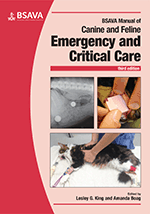
Full text loading...

Patients presenting with cardiovascular emergencies are often unstable and quick decisions are necessary. It is important to keep in mind the main causes of cardiovascular compromise in small animals. This chapter covers: emergency approach in cases suspected of cardiovascular disease, acute heart failure, pericardial effusion, cardiac arrhythmias and arterial thromboembolism.
Cardiovascular emergencies, Page 1 of 1
< Previous page | Next page > /docserver/preview/fulltext/10.22233/9781910443262/9781910443262.6-1.gif

Full text loading...









































